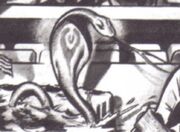
King Cobra is largest type of cobra, and the most dangerous of vipers.
Background[]
Such snakes are is most fearsome and deadly. Some beings are impervious to the cobra's venom, and creatures much larger than the human can withstand the effects of the poison longer. They tend to make their diet of small critters and vermin.[1]
Behind the scenes[]
The cobra on the island in the Swamp was a king cobra, but is usually known as the cobra. In KQ4 Hintbook, it was known as the 'Cobra'.
The cobra appeared in an artwork from one of he early Sierra magazines[2] which was part of an anagram sweepstakes answer. "What is guarding magic fruit in King's Quest IV?"[3]
See also poison, venom, toxin and bane for some of the similarities and differences between terminology. This article is not the place to discuss pedantic online debates on terminology.
"Poisonous snakes" are not uncommon in fairy tales and classic literature from which King's Quest is inspired. Be it from 'poisoning' via venom or snakes being poisonous to eat. See Mohammed with the Magic Finger, The Story of Zoulvisia, or The Snake Prince: in Andrew Lang's Fairy Books. See also Oleg: the Prince Who Was Killed by His Favorite Horse and Charlegmagne and the Snake. The Twelve Brothers in Grimm's Fairy Tales. Sinbad had to deal with poisonous snakes as well.[4], and the story of Riki Tiki Tavi. The use of 'poisonous' to describe snakes and other creatures with venom appears commonly in Gothic literature as well; In The Adventure of the Speckled Band the titular band is a 'poisonous snake', which Sherlock Holmes and Dr. Watson discover as the weapon in a crime..[5] In Bram Stoker's The Lair of the White Worm the worm in question is yet another 'poisonous snake' (not even a beneficial white snake), venomous only appears once but more as a description of malevolence (rather than literal venom). Even the King James Bible uses poisonous/poison when referring to various kinds of poisonous snakes (only uses 'venom' once in one context as synonym of poison). Poisonous Snake is also a common DND creature as well (a 'tiny beast').[6] Notably speaking during middle ages, medieval, dark ages, and early renaissance, poison and venom were interchangeable terms, and venom even came from the Latin word for poison: 'venenum' (both largely having link to 'potions' and 'imbibing'). So the usage of the 'literary' "poisonous" seems rather fitting (its not a zoology or veterinary textbook, its a 'high fantasy/fairy tale game').
References[]
- ↑ KQC3E, 167
- ↑ Sierra Newsletter, Winter 1988, pg 25
- ↑ Sierra Newsletter, Spring 1989, pg26
- ↑ https://books.google.com/books?id=FBasDwAAQBAJ&pg=PT242&lpg=PT242&dq=saint+brendan+poisonous+snake&source=bl&ots=Z9GWihWJKC&sig=ACfU3U1Or1cdu0Z0ffX30orWHz_GRQxtdQ&hl=en&sa=X&ved=2ahUKEwiDx9ilzKnyAhWSZ80KHbqoB84Q6AF6BAgLEAM#v=onepage&q=saint%20brendan%20poisonous%20snake&f=false
- ↑ https://www.owleyes.org/text/adventure-speckled/read/the-advantage-of-the-speckled-band#root-218571-247 The idea of using a form of poison which could not possibly be discovered by any chemical test was just such a one as would occur to a clever and ruthless man who had had an Eastern training. The rapidity with which such a poison would take effect would also, from his point of view, be an advantage. It would be a sharp-eyed coroner, indeed, who could distinguish the two little dark punctures which would show where the poison fangs had done their work. Then I thought of the whistle. Of course he must recall the snake before the morning light revealed it to the victim.
- ↑ https://roll20.net/compendium/dnd5e/Poisonous%20Snake#content